Introducing succulents into your home can be a delightful and rewarding experience for a variety of reasons.
These resilient and visually captivating plants have gained popularity for their unique qualities and ability to thrive in diverse settings.
Whether you’re a seasoned gardener or a beginner in the world of houseplants, here are some compelling reasons why you should consider having succulents in your home:
Low Maintenance: Succulents are known for their easy care. They require minimal attention and are perfect for individuals with busy lifestyles or those new to plant care.
Aesthetic Appeal: Their striking and diverse shapes, sizes, and colors add a touch of natural beauty to any room, creating a soothing and pleasant atmosphere.
Air Quality: Succulents can improve indoor air quality by absorbing toxins and releasing oxygen, contributing to a healthier living environment.
Endless Variety: With thousands of species to choose from, succulents offer endless possibilities for personalizing your home decor.
Resilience: Succulents are hardy and adaptable, making them suitable for different climates and conditions, ensuring they remain vibrant and attractive.
Stress Reduction: Taking care of succulents can be a therapeutic and relaxing hobby, reducing stress and promoting a sense of well-being.
Cost-Effective: They are often budget-friendly and provide lasting beauty, making them a cost-effective choice for enhancing your home’s ambiance.
Incorporating succulents into your home can be a simple yet effective way to enhance your living space while reaping the numerous benefits they offer. Whether you’re seeking a touch of nature or a low-maintenance plant companion, succulents are an excellent choice for homeowners and apartment dwellers alike.
Now I will share with you 9 types of succulents that you can start with.
1. Sedum Morganianum
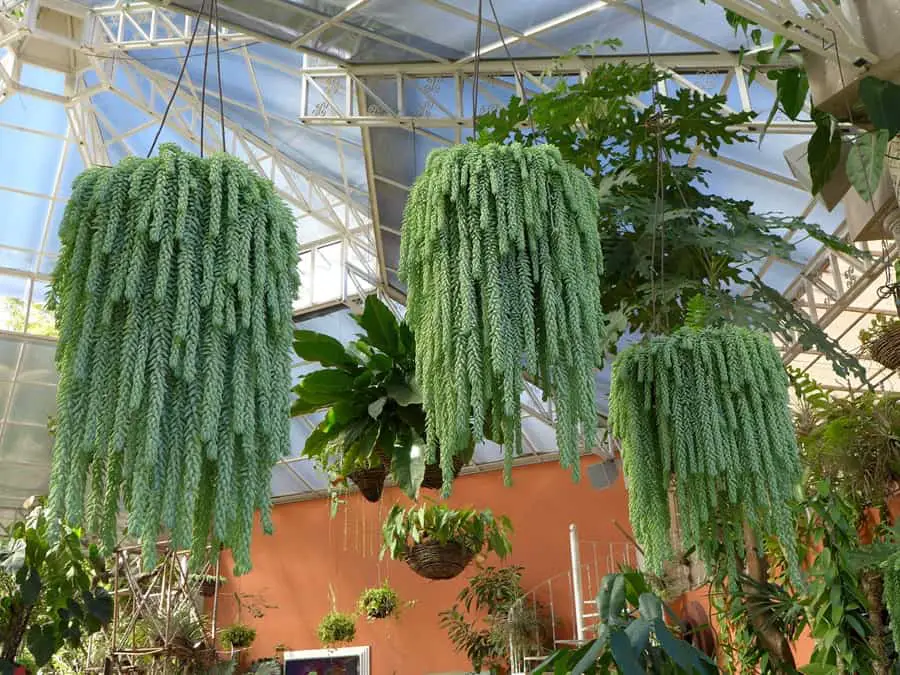
The “Sedum morganianum,” commonly known as the Burro’s Tail or Donkey Tail plant, is a charming succulent that is distinctive for its unique appearance. Here’s a description of this plant and why you should consider adding it to your collection:
Appearance: The Burro’s Tail is characterized by its trailing, cascading stems that are densely covered with small, plump, blue-green leaves. These leaves resemble little beads or droplets, giving the plant its distinct appearance. The plant’s stems can grow quite long, making it an excellent choice for hanging baskets.
Features:
Low Maintenance: This succulent is extremely easy to care for, making it suitable for both beginners and experienced gardeners. It requires minimal attention and can tolerate periods of neglect.
Drought Tolerance: Like most succulents, the Burro’s Tail is highly drought-tolerant. It stores water in its leaves, allowing it to thrive in arid conditions with infrequent watering.
Unique Aesthetic: The trailing growth habit and the lush, succulent leaves make the Burro’s Tail an eye-catching addition to any indoor or outdoor space. It’s an ideal plant for adding a touch of nature to your home decor.
Versatility: Whether placed in a hanging basket, a decorative pot, or even in a garden, the Burro’s Tail can adapt to various settings and can be a striking centerpiece or complement to other plants.
Propagation: The plant is easily propagated from its fallen leaves, making it an excellent choice for those interested in expanding their succulent collection or sharing plants with friends.
Air Purification: Like most succulents, the Burro’s Tail can contribute to improved indoor air quality by absorbing pollutants and releasing oxygen.
Hardiness: It can thrive in a variety of lighting conditions, but it prefers bright, indirect sunlight. This makes it adaptable to different environments.
Incorporating a Burro’s Tail plant into your home or garden not only adds a touch of natural beauty but also provides you with an easy-to-maintain, low-stress plant companion. Its unique aesthetic and minimal care requirements make it a delightful addition to any plant collection, and its cascading stems can create a stunning visual effect, whether hung from a ceiling or placed on a high shelf.
2. Haworthia Fasciata
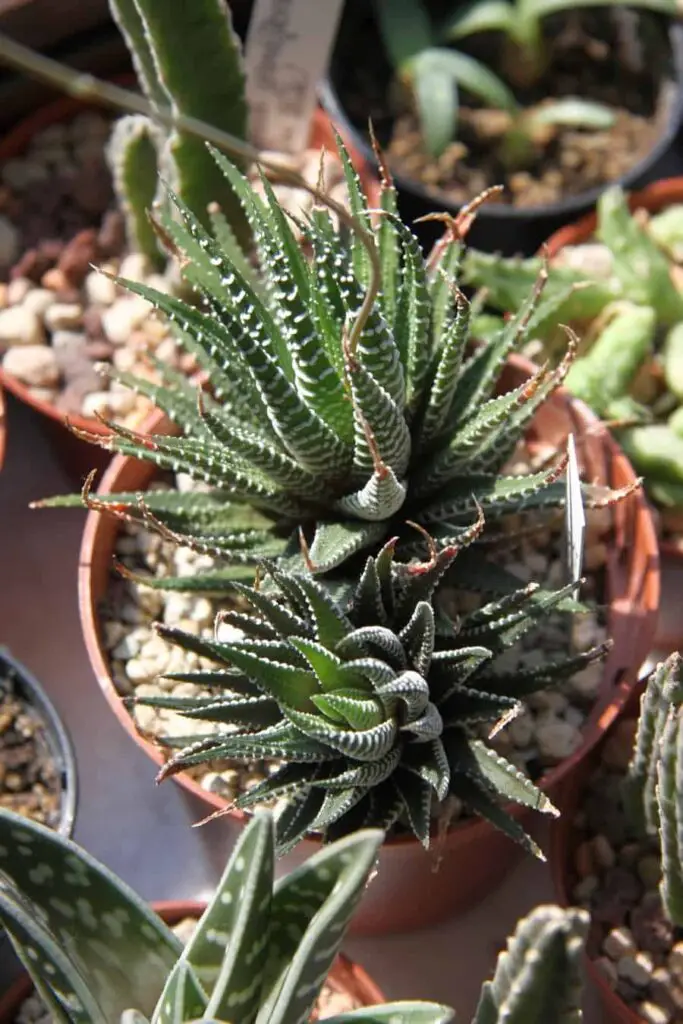
Haworthia fasciata, commonly known as the Zebra Plant, is a captivating succulent species renowned for its striking appearance and ease of care. Here’s a description of this plant and why you should consider adding it to your collection:
The Zebra Plant features compact rosettes of thick, dark green leaves adorned with horizontal white stripes, resembling the stripes of a zebra, hence its name. The leaves are triangular and pointed, and they grow in a neat, symmetric pattern. This succulent’s size is relatively small, making it an ideal choice for indoor spaces and small gardens.
Unique Aesthetic: The Zebra Plant’s distinctive striped pattern is visually captivating, making it an excellent choice for adding a touch of elegance and intrigue to your plant collection or home decor.
Low Maintenance: This succulent is incredibly easy to care for, perfect for both beginners and experienced gardeners. It is a hardy plant that can thrive with minimal attention.
Drought Tolerance: Like many succulents, Haworthia fasciata is drought-resistant and can withstand periods of water scarcity. It stores water in its fleshy leaves, reducing the need for frequent watering.
Indoor Friendliness: Its compact size and adaptability to indoor conditions, including low light, make it an ideal choice for apartments, offices, and homes. It’s also a great option for terrariums and succulent arrangements.
Air Purification: Just like other succulents, the Zebra Plant contributes to improved indoor air quality by removing toxins and releasing oxygen.
Propagation: Haworthia fasciata is relatively easy to propagate through offsets or leaf cuttings, allowing you to expand your collection or share plants with friends and family.
Unique Growth Pattern: The way the leaves grow in a rosette arrangement adds a touch of natural symmetry and order to your space.
Overall, the Zebra Plant is a beautiful and low-maintenance succulent that not only enhances your living space but also provides you with a charming and easy-to-care-for plant companion. Its unique appearance and adaptability to various settings make it a delightful addition to any succulent collection or indoor garden.
You may like: 11 Plants That Grow in Water
3. Aloe Vera
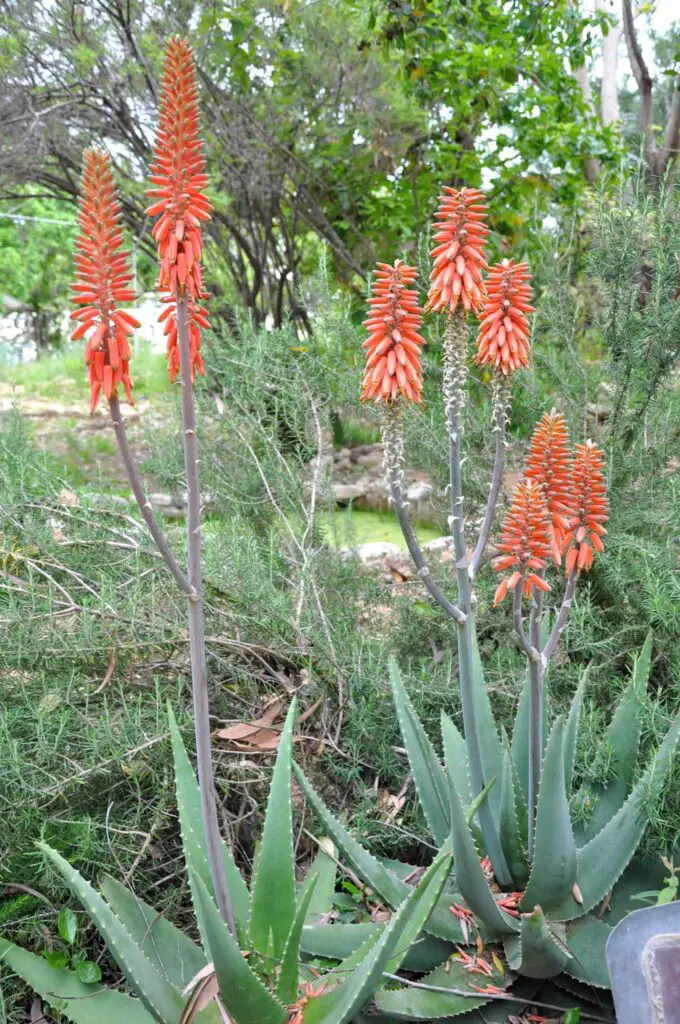
Aloe vera, often referred to as the “wonder plant” or “healing plant,” is a versatile succulent with numerous beneficial properties. Here’s a description of this plant and why you should consider adding it to your collection:
Aloe vera is characterized by its rosette of thick, fleshy, lance-shaped leaves that are typically green with serrated edges. The leaves contain a clear, gel-like substance, which is highly valued for its medicinal and cosmetic uses.
Medicinal Properties: Aloe vera gel has been used for centuries for its healing and soothing properties. It can be applied topically to treat sunburn, minor burns, cuts, and skin irritations. It is also believed to have anti-inflammatory and moisturizing effects on the skin.
Health Benefits: Consuming aloe vera juice (extracted from the plant’s leaves) is thought to have various health benefits, including aiding digestion, supporting the immune system, and providing essential vitamins and minerals.
Low Maintenance: Aloe vera is an extremely low-maintenance plant, making it an ideal choice for those new to gardening. It requires well-drained soil, infrequent watering, and bright, indirect sunlight.
Air Purification: Aloe vera, like other indoor plants, can help improve indoor air quality by absorbing harmful chemicals and releasing oxygen. It’s a great addition to your home for a healthier living environment.
Cosmetic Uses: The gel can be used in DIY skincare recipes for moisturizing face masks, hair treatments, and soothing skin conditions like acne and eczema.
Natural Décor: Aloe vera’s attractive appearance adds a touch of greenery to your indoor space. Its architectural shape and attractive leaves make it a popular choice for home decor.
Multipurpose: The plant can be grown both indoors and outdoors, making it suitable for a wide range of environments, from apartments to gardens.
Incorporating an aloe vera plant into your home not only provides aesthetic appeal but also offers practical benefits for health and wellness. Whether you want a natural remedy for minor skin issues, an air-purifying companion, or a low-maintenance houseplant, aloe vera is a versatile addition to your collection that can serve various purposes.
4. Jade Plant
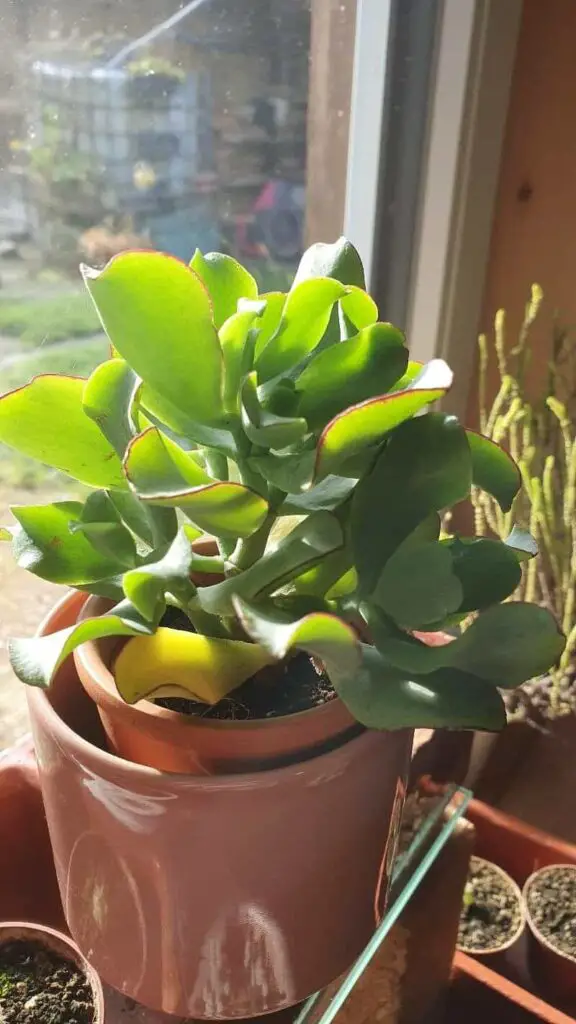
The Jade Plant (Crassula ovata) is a popular and attractive succulent known for its charming appearance and symbolism of prosperity. Here’s a description of this plant and why you should consider adding it to your collection:
Jade Plants are characterized by their thick, fleshy, oval-shaped leaves that are glossy and vibrant green, often with a hint of red or yellow on the edges. They have a compact, bushy growth habit and can reach heights of up to three feet when mature.
Symbolism: The Jade Plant is often associated with good luck, prosperity, and financial success, making it a meaningful and thoughtful gift for friends and family.
Aesthetic Appeal: Its glossy, vibrant leaves add a touch of natural beauty and elegance to your home decor, and its compact size makes it suitable for small spaces.
Low Maintenance: Jade Plants are incredibly easy to care for, making them perfect for both beginners and experienced gardeners. They require minimal attention and can tolerate neglect.
Drought Tolerance: Like most succulents, Jade Plants store water in their leaves, making them highly drought-resistant. They don’t require frequent watering.
Indoor Friendliness: These succulents adapt well to indoor conditions and can thrive in a variety of lighting situations, from bright, indirect light to some direct sunlight.
Air Purification: Like other indoor plants, Jade Plants can help improve indoor air quality by filtering out toxins and releasing oxygen.
Propagation: Jade Plants are easy to propagate from leaves or stem cuttings, allowing you to expand your collection or share plants with others.
Longevity: With proper care, Jade Plants can live for many years, and they are known to be passed down through generations as heirloom plants.
Incorporating a Jade Plant into your indoor garden not only adds a touch of natural beauty but also brings with it the potential for good fortune and prosperity. Its symbolism, low-maintenance nature, and adaptability to various settings make it an ideal choice for those seeking an attractive and meaningful addition to their plant collection or home decor.
5. Senecio Rowleyanus
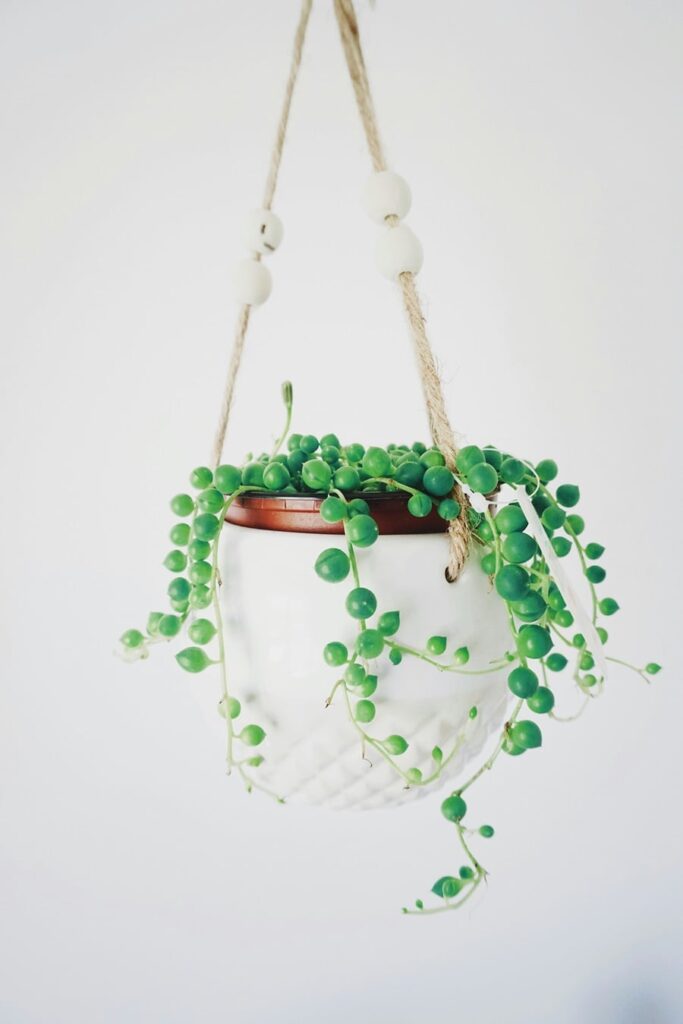
Senecio rowleyanus, commonly known as the “String of Pearls,” is a unique and captivating succulent that is distinguished by its trailing and bead-like leaves. Here’s a description of this plant and why you should consider adding it to your collection:
Appearance:
The String of Pearls plant is instantly recognizable for its distinctive appearance. It features long, trailing stems that are adorned with small, spherical, bead-like leaves. These leaves are typically a vibrant green, resembling a string of pearls, hence the plant’s common name.
Why You Should Get It:
Unique Aesthetic: The String of Pearls is known for its captivating and unusual appearance, making it an excellent choice for adding a touch of whimsy and intrigue to your indoor or outdoor space.
Low Maintenance: This succulent is incredibly easy to care for, making it suitable for both novice and experienced gardeners. It requires minimal attention and can thrive with infrequent watering.
Drought Tolerance: Like most succulents, Senecio rowleyanus is highly drought-resistant due to its ability to store water in its bead-like leaves.
Indoor and Outdoor Versatility: You can grow the String of Pearls indoors as a hanging plant or in a decorative pot, or outdoors in a hanging basket, rock garden, or as a ground cover. It is adaptable to various environments.
Air Purification: Like many indoor plants, the String of Pearls can help improve indoor air quality by absorbing pollutants and releasing oxygen.
Unique Growth Pattern: The cascading, pearl-like foliage adds a dynamic and visually appealing element to your space.
Propagation: This plant is easy to propagate from stem cuttings, allowing you to expand your collection or share it with friends.
The String of Pearls is a charming and low-maintenance succulent that not only enhances the visual appeal of your surroundings but also provides you with an intriguing and easy-to-care-for plant companion. Its unique aesthetics and adaptability to different settings make it an excellent choice for anyone looking to add a touch of natural beauty and curiosity to their plant collection.
6. Sempervivum Tectorum
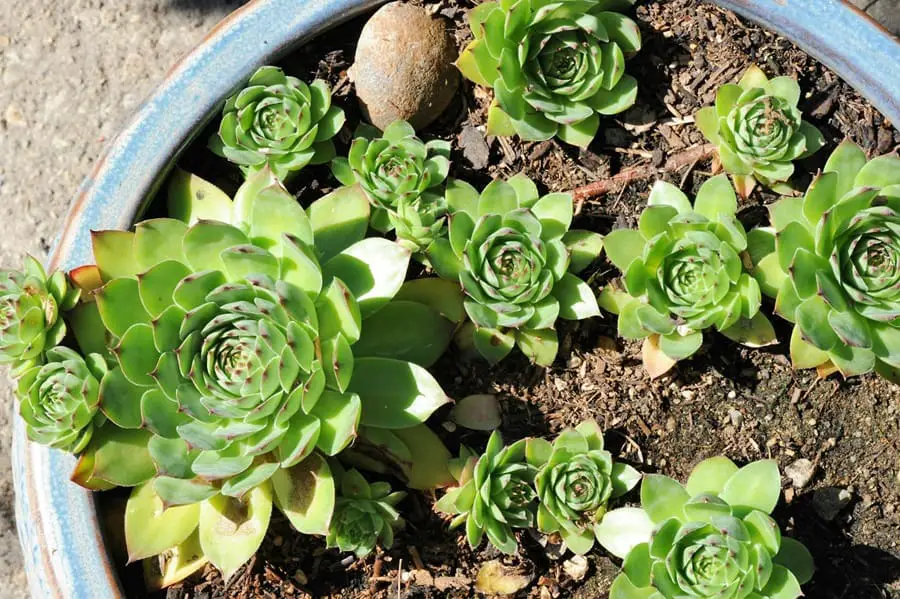
Sempervivum tectorum, commonly known as “Hens and Chicks” or “Houseleek,” is a hardy and visually appealing succulent plant that’s cherished for its unique appearance and resilience. Here’s a description of this plant and why you should consider adding it to your collection:
Sempervivum tectorum is a low-growing, rosette-forming succulent with fleshy, pointed leaves that come in a variety of colors, including shades of green, red, and even silver. The leaves are densely packed in a circular arrangement, resembling a small, evergreen rose. The “Hens and Chicks” name derives from its growth pattern, where the main rosette (the “hen”) produces smaller offsets (the “chicks”) around it.
Unique Aesthetic: Sempervivum tectorum’s charming rosettes, with their striking colors and textures, make it a delightful addition to your indoor or outdoor garden.
Low Maintenance: This succulent is incredibly easy to care for, making it ideal for beginners. It is drought-tolerant and requires minimal attention, making it a hassle-free choice for busy individuals.
Cold Hardy: Sempervivum tectorum is known for its cold resistance, making it suitable for gardens in temperate climates. It can even thrive in colder months when other plants may struggle.
Drought Tolerance: Like most succulents, it can store water in its leaves, allowing it to withstand dry periods with minimal watering.
Indoor and Outdoor Versatility: You can grow Hens and Chicks both indoors in pots or outdoor in rock gardens, container gardens, or ground cover, making it a versatile plant choice.
Unique Growth Pattern: The way it produces offsets around the main rosette provides a dynamic and visually appealing display.
Propagation: Sempervivum tectorum is easy to propagate by removing and replanting the “chicks” that grow around the main rosette, allowing you to expand your collection or share it with others.
Whether you’re seeking a visually captivating succulent for your indoor garden, a resilient addition to your outdoor landscape, or simply a low-maintenance plant to brighten up your space, Sempervivum tectorum is an excellent choice. Its unique growth pattern and striking appearance make it a valuable asset to your plant collection, and its resilience ensures long-lasting enjoyment.
7. Echeveria Pulvinata

Echeveria pulvinata, commonly known as “Ruby Blush” or “Chenille Plant,” is a charming succulent that stands out for its unique appearance and easy care. Here’s a description of this plant and why you should consider adding it to your collection:
Echeveria pulvinata is a low-growing, rosette-forming succulent with soft, fleshy leaves covered in fine, silvery-white hairs, giving the plant a fuzzy or velvety texture. The leaves are typically green to bluish-green, with reddish or purplish margins. The rosette shape is compact and can grow up to 8 inches in diameter.
Unique Aesthetic: Ruby Blush’s soft, velvety texture and eye-catching coloration make it a delightful and distinct addition to your indoor or outdoor garden.
Low Maintenance: This succulent is known for being easy to care for, making it a great choice for both beginners and experienced gardeners. It’s drought-tolerant and requires minimal attention.
Colorful Foliage: The plant’s green to bluish-green leaves with reddish or purplish edges create an attractive and visually appealing contrast.
Indoor and Outdoor Versatility: You can grow Echeveria pulvinata both indoors in containers or outdoors in rock gardens, succulent beds, or as part of a xeriscape landscape.
Drought Tolerance: Like most succulents, it stores water in its leaves, allowing it to thrive in dry conditions with infrequent watering.
Propagation: Echeveria pulvinata is easy to propagate from offsets or leaf cuttings, which means you can expand your collection or share it with friends and family.
Air Purification: Just like many other indoor plants, it contributes to improved indoor air quality by removing toxins and releasing oxygen.
Whether you’re looking for a visually captivating succulent for your home, garden, or office, or simply want a low-maintenance plant that can thrive with minimal care, Echeveria pulvinata is a fantastic choice. Its distinctive appearance, ease of care, and adaptability to various settings make it a valuable addition to your plant collection.
8. Christmas Cactus
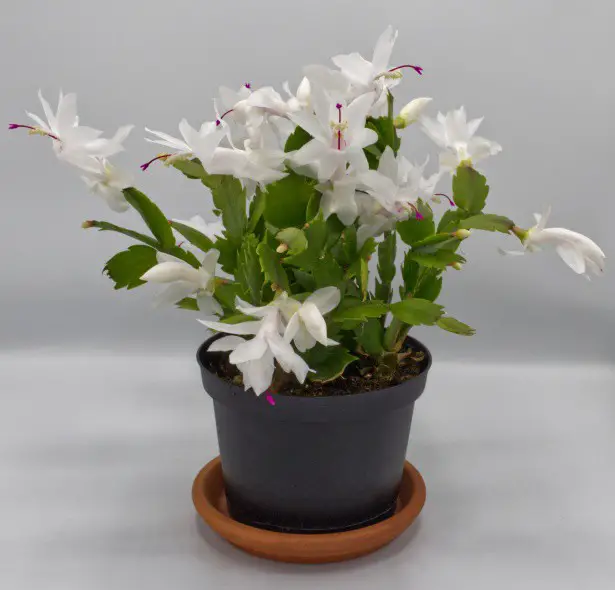
Christmas Cactus (Schlumbergera spp.) is a popular and festive houseplant known for its striking appearance and ability to bloom during the holiday season. Here’s a description of this plant and why you should consider adding it to your collection:
Appearance:
The Christmas Cactus is a trailing or epiphytic succulent with segmented, flat stems that give it a distinctive, leaf-like appearance. Its stems are typically green, but some varieties may have a reddish or purplish hue. The plant produces beautiful, tubular flowers that come in a range of colors, including pink, red, white, and even lavender, creating a spectacular display.
Why You Should Get It:
Festive Bloom: The Christmas Cactus is named for its ability to produce vibrant, tubular flowers in late fall and winter, making it a perfect plant to add a touch of holiday cheer to your home.
Low Maintenance: This houseplant is relatively easy to care for, making it suitable for both beginners and experienced gardeners. It thrives with minimal attention.
Longevity: With proper care, Christmas Cacti can live for many years and continue to bloom annually, becoming a cherished part of your holiday traditions.
Indoor Friendliness: This plant is well-suited for indoor conditions and adapts to various lighting situations, from bright, indirect light to some direct sunlight.
Variety: There are several different Schlumbergera species and cultivars to choose from, offering a range of flower colors and shapes.
Air Purification: Like many houseplants, the Christmas Cactus can contribute to improved indoor air quality by absorbing pollutants and releasing oxygen.
Propagation: You can easily propagate new plants from stem cuttings, allowing you to share or expand your collection.
Incorporating a Christmas Cactus into your home not only adds a festive touch during the holiday season but also provides you with a visually appealing and low-maintenance plant companion throughout the year. Its striking flowers and adaptability to indoor environments make it an excellent choice for anyone looking to brighten up their space and celebrate the holiday season with a touch of natural beauty.
9. Aeonium Arboreum
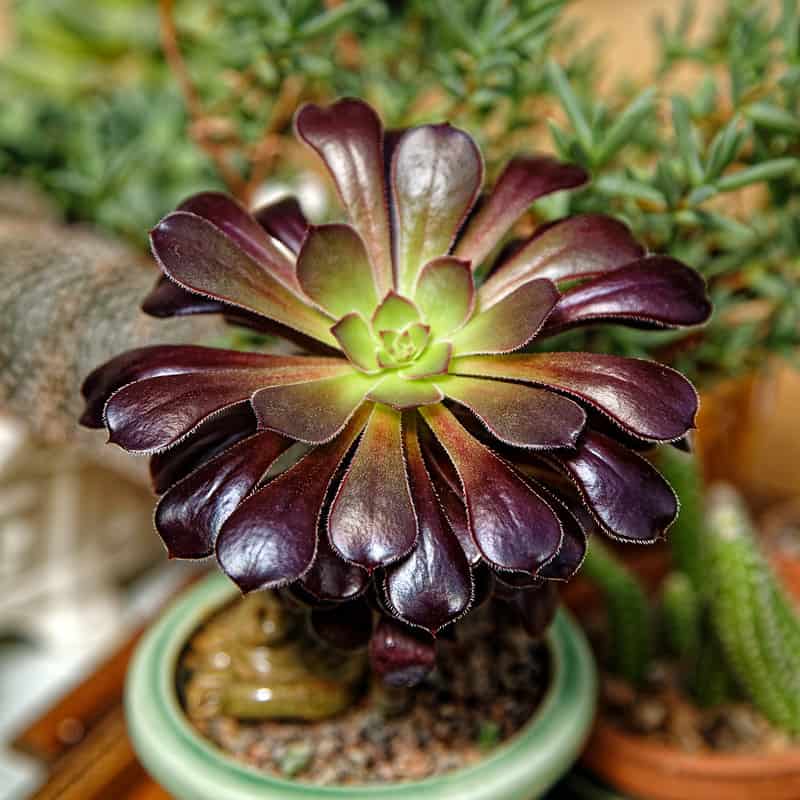
Aeonium arboreum, commonly known as the “Tree Aeonium” or “Black Rose,” is a stunning succulent that stands out for its unique growth pattern and striking appearance. Here’s a description of this plant and why you should consider adding it to your collection:
Appearance:
Aeonium arboreum is a rosette-forming succulent with a woody stem that can grow into a small shrub-like structure. The leaves are arranged in rosettes at the ends of the stems, and they are typically dark green, almost black, in color. The rosettes have a distinctive and elegant shape, with leaves that are spoon-shaped and glossy.
Why You Should Get It:
Unique Aesthetic: The dark, almost black, rosettes of Aeonium arboreum create a striking and visually captivating contrast, making it an excellent choice for adding drama to your indoor or outdoor garden.
Low Maintenance: This succulent is known for its ease of care, making it suitable for both beginners and experienced gardeners. It is drought-tolerant and requires minimal attention.
Architectural Form: The tree-like structure and the rosettes’ arrangement at the ends of the stems give the plant an architectural and sculptural quality, adding interest to your plant collection or garden.
Indoor and Outdoor Versatility: While it thrives in outdoor gardens, Aeonium arboreum can also be grown indoors in containers, making it adaptable to various settings.
Drought Tolerance: Like many succulents, it can store water in its leaves, allowing it to withstand dry conditions with infrequent watering.
Seasonal Changes: During the growing season, the rosettes may produce small, star-shaped yellow flowers, adding another layer of interest to the plant.
Propagation: Aeonium arboreum is easily propagated from stem cuttings, providing an opportunity to share or expand your succulent collection.
Whether you’re looking to enhance your garden with a unique and architectural focal point or add a dramatic element to your indoor plant collection, Aeonium arboreum, with its dark rosettes and ease of care, is an excellent choice.
Its distinctive appearance and adaptability make it a valuable addition for succulent enthusiasts and those looking to explore unique and low-maintenance plant varieties.
